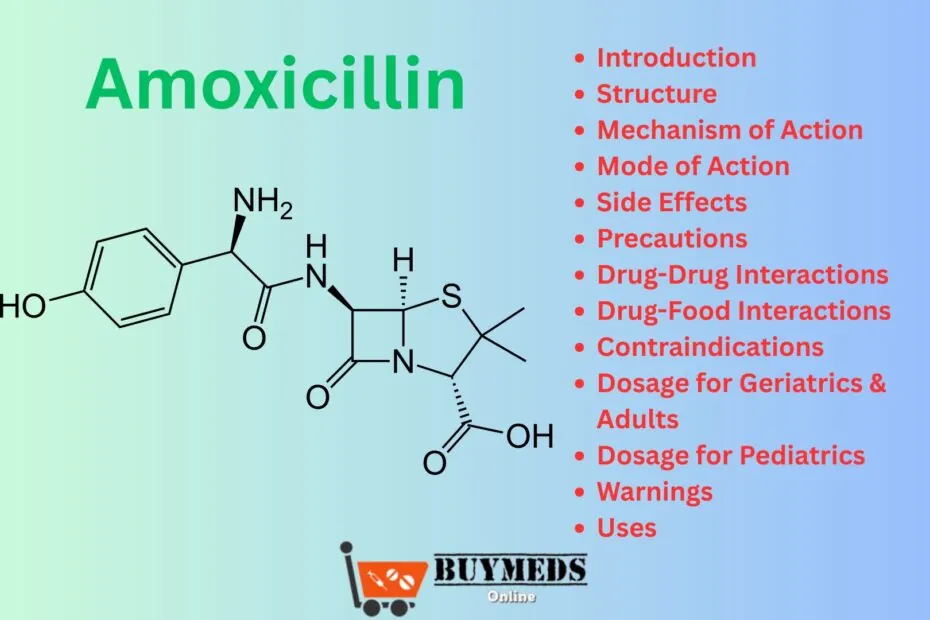Introduction
Amoxicillin is a widely prescribed broad-spectrum, beta-lactam antibiotic belonging to the penicillin group. It is commonly used to treat a range of bacterial infections including respiratory tract infections, urinary tract infections, ear infections, skin infections, and dental abscesses. Amoxicillin is known for its effectiveness, good absorption, and generally mild side effect profile. It is available in capsule, tablet, chewable, and suspension forms.
Structure
Amoxicillin has the chemical formula of C16H19N3O5S.
Its structure consists of a beta-lactam ring fused with a thiazolidine ring, and a side chain that enhances its spectrum of activity compared to earlier penicillins. The structural modifications allow for better oral bioavailability and stability against stomach acid.
Mechanism of Action
Amoxicillin exerts its antibacterial effects by inhibiting bacterial cell wall synthesis. It binds to penicillin-binding proteins (PBPs) within the bacterial cell wall, interfering with the cross-linking of peptidoglycan chains, which are essential for cell wall strength and rigidity. The disruption of this process leads to cell lysis and death in susceptible bacteria.
Mode of Action
Amoxicillin is bactericidal in nature. It actively kills bacteria by targeting the synthesis of their cell walls. It is effective primarily against Gram-positive and some Gram-negative organisms. Its action is enhanced when combined with clavulanic acid, a beta-lactamase inhibitor, which protects amoxicillin from enzymatic degradation by resistant bacteria.
Side Effects
Common side effects of amoxicillin include:
-
Nausea
-
Vomiting
-
Diarrhea
-
Skin rash
-
Headache
Rare but serious adverse effects:
-
Anaphylaxis (severe allergic reaction)
-
Stevens-Johnson Syndrome
-
Clostridioides difficile-associated diarrhea
-
Hepatic dysfunction
-
Seizures (at very high doses)
Precautions
-
Avoid use in patients with known hypersensitivity to penicillins.
-
Use with caution in patients with a history of allergic reactions to cephalosporins.
-
Monitor renal function in patients with renal impairment.
-
In patients with mononucleosis, administration may cause a characteristic non-allergic rash.
Drug-Drug Interactions
-
Allopurinol: Increases the risk of skin rash.
-
Oral contraceptives: May reduce effectiveness; recommend additional birth control.
-
Anticoagulants (e.g., warfarin): May increase bleeding risk due to altered gut flora.
-
Methotrexate: Amoxicillin may decrease its renal clearance, increasing toxicity.
Drug-Food Interactions
-
Food does not significantly affect the absorption of amoxicillin.
-
However, to maximize absorption and minimize gastrointestinal side effects, it can be taken at the start of a meal.
-
Alcohol does not directly interact with amoxicillin but may worsen side effects like stomach upset and dizziness.
Contraindications
-
Known hypersensitivity to amoxicillin, other penicillins, or beta-lactam antibiotics.
-
History of severe allergic reactions (e.g., anaphylaxis) to any beta-lactam antibiotics.
-
Infectious mononucleosis (due to increased risk of rash).
Dosage for Geriatrics & Adults
Adults & Elderly (dose adjustments may be needed for renal impairment):
-
Standard infections: 250–500 mg every 8 hours or 500–875 mg every 12 hours.
-
Severe infections: Up to 1 g every 8 hours.
-
Renal impairment: Adjust dosage based on creatinine clearance.
Dosage for Pediatrics
Children (based on body weight):
-
Mild to moderate infections: 20–40 mg/kg/day divided every 8 hours.
-
Severe infections: 40–90 mg/kg/day divided every 8–12 hours.
-
Always consult pediatric dosing guidelines and adjust for weight and age.
Warnings
-
May cause serious allergic reactions, including anaphylaxis.
-
Prolonged use may lead to superinfection with resistant organisms.
-
Use with caution in patients with renal impairment and adjust dose accordingly.
-
Diarrhea may signal antibiotic-associated colitis, including C. difficile infection.
Uses
Amoxicillin is used to treat:
-
Acute otitis media
-
Streptococcal pharyngitis
-
Sinusitis
-
Bronchitis and pneumonia
-
Urinary tract infections (UTIs)
-
Skin and soft tissue infections
-
Dental abscesses
-
Helicobacter pylori infection (in combination therapy)
Expert Advice
-
Complete the full course even if symptoms improve before completion.
-
Store oral suspension in the refrigerator and discard after 14 days.
-
Inform your healthcare provider about any history of allergies before starting.
-
If a dose is missed, take it as soon as possible. Do not double the dose.
FAQs
Q1: Is amoxicillin a strong antibiotic?
A: Yes, it is considered a potent broad-spectrum antibiotic effective against many bacterial infections.
Q2: Can I take amoxicillin on an empty stomach?
A: Yes, but taking it with food can reduce gastrointestinal side effects.
Q3: How quickly does amoxicillin work?
A: Improvement is often seen within 1–2 days, but full effect may take several days depending on the infection.
Q4: Can I drink alcohol with amoxicillin?
A: While not directly harmful, it is advisable to avoid alcohol to reduce side effects and allow the body to recover faster.
Q5: Does amoxicillin treat viral infections?
A: No. Amoxicillin is effective only against bacterial infections, not viruses like the flu or common cold.
Frequent Search Terms: Amoxicillin, Amoxicillin dosage, Amoxicillin side effects, Amoxicillin uses, antibiotic for infection, Amoxicillin for kids, Amoxicillin precautions, drug interactions Amoxicillin, penicillin antibiotic.
